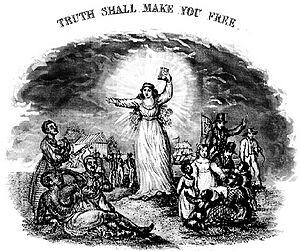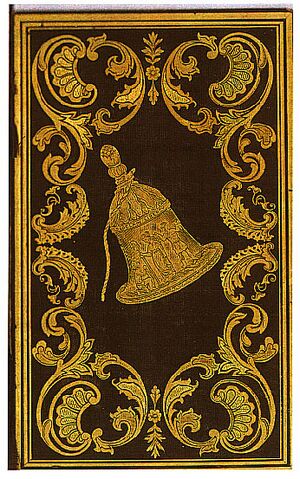The Liberty Bell (annual) facts for kids
The Liberty Bell, by Friends of Freedom was a special yearly book. It was an abolitionist "gift book" that helped fight against slavery. Maria Weston Chapman edited and published this book. It was sold or given away at the National Anti-Slavery Bazaar, an event organized by the Boston Female Anti-Slavery Society. The book was named after the Liberty Bell, a famous symbol of freedom in America. It was published almost every year from 1839 to 1858.
Contents
What Was the Liberty Bell Book?
How the Book Started
In 1834, Maria Weston Chapman from Boston, Massachusetts, and her sisters Caroline, Anne, and Deborah, along with eight other women, created the Boston Female Anti-Slavery Society. This group worked to end slavery.
To raise money for their work, they held an "Anti-Slavery Fair" in Boston. The first fair was in 1834. Maria and her sister Anne were the main organizers. These fairs became popular social events in Boston.
Raising Money for Freedom
The fair organizers raised thousands of dollars each year. They sold many different items, like "ladies' aprons, cloaks, cuffs, bags, purses," "knitted quilts," "inkstands," and even "Ohio cheese." They also sold "dolls in hundreds of every size, price, material, and costume."
In 1839, The Liberty Bell book joined these items. It was like the popular "gift books" of that time. People bought the book at the fair. Fair workers also received a copy for free to thank them for their help. The book was published every year until 1846. After that, it came out sometimes until the 1859 edition, which was made in 1858. (The years 1840, 1850, 1855, and 1857 were missed.)
Like many gift books, The Liberty Bell was usually printed late in the year before its official date. For example, the book dated 1841 was actually printed in late 1840. The very first edition, however, was printed in 1839 for the 1839 date.
What Was Inside the Book?
Who Wrote for The Liberty Bell?
As the editor, Maria Chapman wrote a lot of the book herself. She wrote stories, essays, and poems. She also asked her sisters to contribute.
Maria also asked many famous writers to help. These included Lydia Maria Child, Eliza Cabot Follen, Wendell Phillips, Henry Wadsworth Longfellow, James Russell Lowell, Lucretia Mott, William Lloyd Garrison, and Harriet Martineau. Many of these writers were leaders in the abolitionist movement or supported it.
The Book's Purpose
In 1848, Maria Chapman explained the book's goal: "The purpose of this little annual volume... is, the promotion of the cause through the promulgation of its principles in an attractive form." This means the book wanted to spread ideas about ending slavery in a way that people would enjoy reading.
She also made sure that only writers who supported the anti-slavery cause were included. She did not allow writers who were against the cause or its supporters to be in the book.
Famous Writers and Their Contributions
Maria's efforts to get writers from further away were also successful. The Liberty Bell published two works by the famous poet Elizabeth Barrett Browning.
- The Runaway Slave at Pilgrim's Point was published in December 1847 for the 1848 edition.
- A Curse for a Nation was published in December 1855 for the 1856 edition.
These works were later published in England, but with small changes.
Unlike other commercial gift books where authors were paid, writers for The Liberty Bell usually did not get money for their work. They only received a free copy of the book itself.
How Was The Liberty Bell Book Seen?
Different Opinions on Quality
People had different ideas about how good The Liberty Bell was. Some thought the writing was not very good. One expert, Ralph Thompson, said that "throughout the fifteen volumes... there is hardly to be found one creation of aesthetic value." This means he thought the writing wasn't artistic or beautiful.
However, others thought the book was good enough. Another expert, Clare Taylor, called it "a good magazine." She said its "standards were high, and items were convincing." She believed the anti-slavery movement needed such writing to gain support.
Was It Effective?
Opinions also differed on how well the book convinced people. Thompson thought that "like all unadulterated reform literature, the Liberty Bell circulated among those people who already knew and accepted the tenets it upheld." He felt it probably didn't make many new supporters.
But Taylor believed that "From the outset the Liberty Bell was the most significant anti-slavery annual in America." She thought it "made a real contribution to the anti-slavery movement." However, even Taylor mentioned the "sentimental tales of terror which filled every issue" and the "silly sensationalism" of some pieces. She concluded that "their methods were crude and simplistic, even if their intentions were good." Taylor rated Elizabeth Barrett Browning's two contributions as the best in the book.
Images for kids





